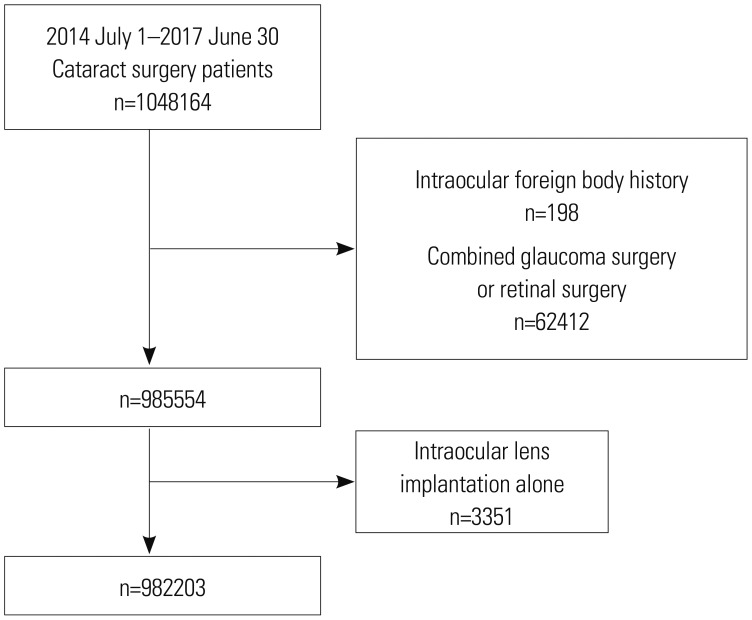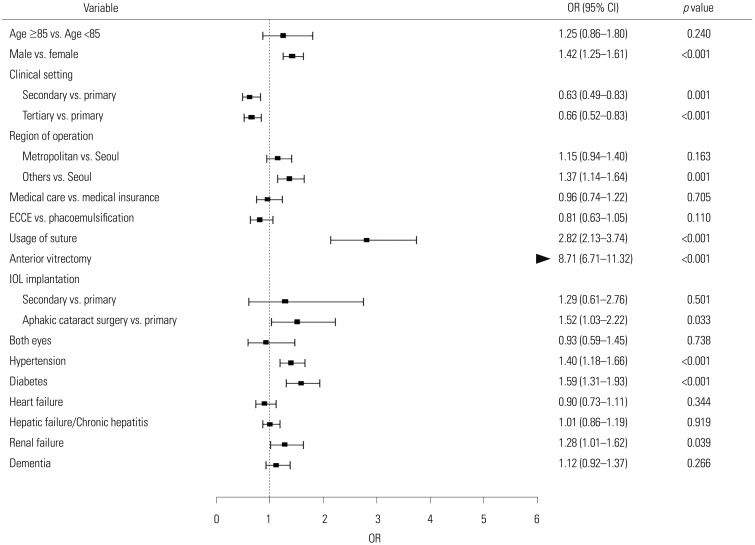Yonsei Med J.
2019 May;60(5):467-473. 10.3349/ymj.2019.60.5.467.
Endophthalmitis after Cataract Surgery in Korea: A Nationwide Study Evaluating Incidence and Risk Factors in a Korean Population
- Affiliations
-
- 1Department of Ophthalmology, Yonsei University Wonju College of Medicine, Wonju, Korea. shrah@yonsei.ac.kr
- 2Department of Biostatistics, Yonsei University Wonju College of Medicine, Wonju, Korea.
- KMID: 2443251
- DOI: http://doi.org/10.3349/ymj.2019.60.5.467
Abstract
- PURPOSE
To assess the nationwide rate of acute postoperative endophthalmitis (APE) after cataract extraction in Korea and to evaluate potential risk factors thereof.
MATERIALS AND METHODS
Nationwide insurance claims data from July 2014 to June 2017 were reviewed. All patients with phacoemulsification or extracapsular/intracapsular cataract extraction were included. Exclusion criteria were combined glaucoma surgery or total vitrectomy or when the patient had a history of intraocular foreign body.
RESULTS
In total, 1505103 cases (982203 patients) were included. APE developed in 953 cases (938 patients) with an overall incidence of 0.063%. After adjusting for possible confounding factors, male sex [odds ratio (OR) 1.42; 95% confidence interval (CI) 1.25-1.61; p<0.001], primary clinical setting, operations performed in non-major cities, usage of sutures (OR 2.82; 95% CI 2.13-3.74; p<0.001), anterior vitrectomy (OR 8.71; 95% CI 6.71-11.32; p<0.001), aphakic cataract surgery (OR 1.52; 95% CI 1.03-2.22; p=0.033), hypertension (OR 1.40; 95% CI 1.18-1.66; p<0.001), diabetes (OR 1.59; 95% CI 1.31-1.93; p<0.001), and chronic renal failure (OR 1.28; 95% CI 1.01-1.62; p=0.039) were found to be related to APE development.
CONCLUSION
The incidence of APE after cataract extraction was consistent with reports from other studies. Additional research is needed to determine the relationship of newly found risk factors, such as hypertension, primary clinical setting, chronic renal failure, and usage of suturing, with APE development.
Keyword
MeSH Terms
Figure
Reference
-
1. Weikert MP. Update on bimanual microincisional cataract surgery. Curr Opin Ophthalmol. 2006; 17:62–67. PMID: 16436926.
Article2. Yorston D. Cataract complications. Community Eye Health. 2008; 21:1–3. PMID: 18504465.3. Sugar A, Schertzer RM. Clinical course of phacoemulsification wound burns. J Cataract Refract Surg. 1999; 25:688–692. PMID: 10330646.
Article4. Wong TY, Chee SP. The epidemiology of acute endophthalmitis after cataract surgery in an Asian population. Ophthalmology. 2004; 111:699–705. PMID: 15051201.5. Greenberg PB, Tseng VL, Wu WC, Liu J, Jiang L, Chen CK, et al. Prevalence and predictors of ocular complications associated with cataract surgery in United States veterans. Ophthalmology. 2011; 118:507–514. PMID: 21035868.
Article6. West ES, Behrens A, McDonnell PJ, Tielsch JM, Schein OD. The incidence of endophthalmitis after cataract surgery among the U.S. Medicare population increased between 1994 and 2001. Ophthalmology. 2005; 112:1388–1394. PMID: 15953637.
Article7. Creuzot-Garcher C, Benzenine E, Mariet AS, de Lazzer A, Chiquet C, Bron AM, et al. Incidence of acute postoperative endophthalmitis after cataract surgery: a nationwide study in France from 2005 to 2014. Ophthalmology. 2016; 123:1414–1420. PMID: 26992840.8. Jabbarvand M, Hashemian H, Khodaparast M, Jouhari M, Tabatabaei A, Rezaei S. Endophthalmitis occurring after cataract surgery: outcomes of more than 480 000 cataract surgeries, epidemiologic features, and risk factors. Ophthalmology. 2016; 123:295–301. PMID: 26704882.9. Hashemian H, Mirshahi R, Khodaparast M, Jabbarvand M. Post-cataract surgery endophthalmitis: brief literature review. J Curr Ophthalmol. 2016; 28:101–105. PMID: 27579452.
Article10. Montan PG, Wejde G, Koranyi G, Rylander M. Prophylactic intracameral cefuroxime. Efficacy in preventing endophthalmitis after cataract surgery. J Cataract Refract Surg. 2002; 28:977–981. PMID: 12036639.11. García-Sáenz MC, Arias-Puente A, Rodríguez-Caravaca G, Bañuelos JB. Effectiveness of intracameral cefuroxime in preventing endophthalmitis after cataract surgery: ten-year comparative study. J Cataract Refract Surg. 2010; 36:203–207. PMID: 20152598.12. Haripriya A, Chang DF, Namburar S, Smita A, Ravindran RD. Efficacy of intracameral moxifloxacin endophthalmitis prophylaxis at Aravind Eye Hospital. Ophthalmology. 2016; 123:302–308. PMID: 26522705.13. Lundström M, Wejde G, Stenevi U, Thorburn W, Montan P. Endophthalmitis after cataract surgery: a nationwide prospective study evaluating incidence in relation to incision type and location. Ophthalmology. 2007; 114:866–870. PMID: 17324467.14. Kim L, Kim JA, Kim S. A guide for the utilization of Health Insurance Review and Assessment Service National Patient Samples. Epidemiol Health. 2014; 36:e2014008. PMID: 25078381.
Article15. Jang MJ, Bang SM, Oh D. Incidence of venous thromboembolism in Korea: from the Health Insurance Review and Assessment Service database. J Thromb Haemost. 2011; 9:85–91. PMID: 20942850.
Article16. Aaberg TM Jr, Flynn HW Jr, Schiffman J, Newton J. Nosocomial acute-onset postoperative endophthalmitis survey. A 10-year review of incidence and outcomes. Ophthalmology. 1998; 105:1004–1010. PMID: 9627649.17. Miller JJ, Scott IU, Flynn HW Jr, Smiddy WE, Newton J, Miller D. Acute-onset endophthalmitis after cataract surgery (2000–2004): incidence, clinical settings, and visual acuity outcomes after treatment. Am J Ophthalmol. 2005; 139:983–987. PMID: 15953426.
Article18. Quiroz Y, Johnson RJ, Rodríguez-Iturbe B. The role of T cells in the pathogenesis of primary hypertension. Nephrol Dial Transplant. 2012; 27(Suppl 4):iv2–iv5. PMID: 23036901.
Article19. Takeichi N, Suzuki K, Okayasu T, Kobayashi H. Immunological depression in spontaneously hypertensive rats. Clin Exp Immunol. 1980; 40:120–126. PMID: 6993074.
Article20. Kato S, Chmielewski M, Honda H, Pecoits-Filho R, Matsuo S, Yuzawa Y, et al. Aspects of immune dysfunction in end-stage renal disease. Clin J Am Soc Nephrol. 2008; 3:1526–1533. PMID: 18701615.
Article21. Health Insurance Review and Assessment Service. Hospital list. accessed on 2017 October 19. Available at: https://www.hira.or.kr/rd/hosp/getHospList.do.22. Norregaard JC, Thoning H, Bernth-Petersen P, Andersen TF, Javitt JC, Anderson GF. Risk of endophthalmitis after cataract extraction: results from the International Cataract Surgery Outcomes study. Br J Ophthalmol. 1997; 81:102–106. PMID: 9059242.
Article23. Desai P. The national cataract surgery survey: II. Clinical outcomes. Eye (Lond). 1993; 7(Pt 4):489–494. PMID: 8253226.
Article24. Lundström M, Brege KG, Florén I, Lundh B, Stenevi U, Thorburn W. Postoperative aphakia in modern cataract surgery: part 2: detailed analysis of the cause of aphakia and the visual outcome. J Cataract Refract Surg. 2004; 30:2111–2115. PMID: 15474823.25. Al Mahmood AM, Al-Swailem SA, Behrens A. Clear corneal incision in cataract surgery. Middle East Afr J Ophthalmol. 2014; 21:25–31. PMID: 24669142.
Article26. Taban M, Behrens A, Newcomb RL, Nobe MY, Saedi G, Sweet PM, et al. Acute endophthalmitis following cataract surgery: a systematic review of the literature. Arch Ophthalmol. 2005; 123:613–620. PMID: 15883279.27. Lertsumitkul S, Myers PC, O'Rourke MT, Chandra J. Endophthalmitis in the western Sydney region: a case-control study. Clin Exp Ophthalmol. 2001; 29:400–405. PMID: 11778811.
Article28. Nagaki Y, Hayasaka S, Kadoi C, Matsumoto M, Yanagisawa S, Watanabe K, et al. Bacterial endophthalmitis after small-incision cataract surgery. Effect of incision placement and intraocular lens type. J Cataract Refract Surg. 2003; 29:20–26. PMID: 12551662.29. Matossian C, Makari S, Potvin R. Cataract surgery and methods of wound closure: a review. Clin Ophthalmol. 2015; 9:921–928. PMID: 26045656.30. Masket S, Hovanesian JA, Levenson J, Tyson F, Flynn W, Endl M, et al. Hydrogel sealant versus sutures to prevent fluid egress after cataract surgery. J Cataract Refract Surg. 2014; 40:2057–2066. PMID: 25465686.
Article31. Lee BJ, Smith SD, Jeng BH. Suture-related corneal infections after clear corneal cataract surgery. J Cataract Refract Surg. 2009; 35:939–942. PMID: 19393897.
Article32. Thoms SS, Musch DC, Soong HK. Postoperative endophthalmitis associated with sutured versus unsutured clear corneal cataract incisions. Br J Ophthalmol. 2007; 91:728–730. PMID: 17510477.
Article
- Full Text Links
- Actions
-
Cited
- CITED
-
- Close
- Share
- Similar articles
-
- Factors Associated with Visual Outcomes of Postoperative Endophthalmitis Following Cataract Surgery
- The Complications of Cataract Extraction
- Bilateral Staphylococcus Epidermidis Endophthalmitis After Cataract Extraction
- Early Developed Candida Endophthalmitis Following Intracapsular Cataract Extraction
- Postoperative Endophthalmitis Following Cataract Surgery Over an Eight-Year Period



